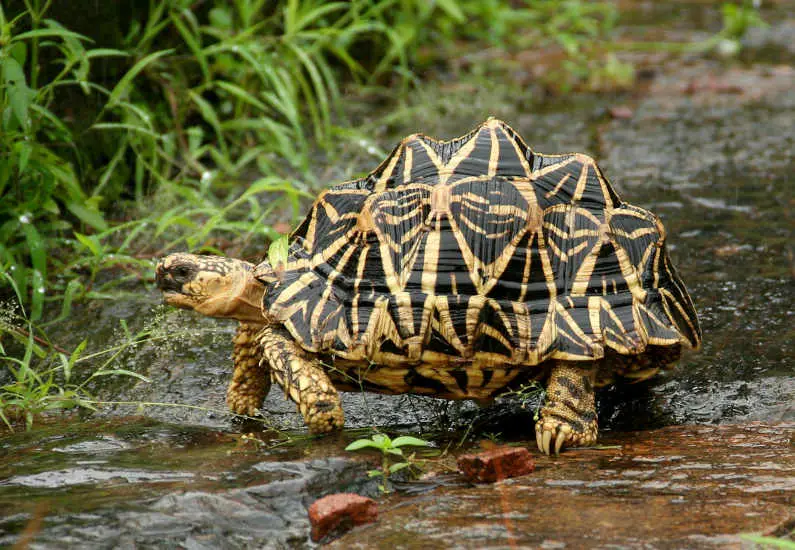The Indian Star Tortoises(Geochelone elegans) captivate wildlife enthusiasts and pet owners alike with their stunning star-patterned shells and gentle demeanors. Native to the dry and arid forests of India, Sri Lanka, and Pakistan, these creatures are not only a marvel of nature but also a testament to the complexity of reptilian life. This article delves into their natural habitat, behavior, conservation status, and the ethical considerations of keeping them as pets, providing a comprehensive overview of one of nature’s most beautifully adorned reptiles.
The Natural Habitat of the Indian Star Tortoise
Indian Star Tortoises thrive in a variety of dry habitats, including scrub forests, grasslands, and some arid, thorny areas. These environments offer the ideal conditions for their survival, providing adequate sunlight for thermoregulation and plenty of vegetation for food. The adaptability of these tortoises to varying micro-climates within their range plays a crucial role in their long-term survival.
Behavioral Traits and Lifestyle
One of the most fascinating aspects of the Indian Star Tortoise is its behavior. These tortoises are primarily diurnal, spending a significant portion of their day foraging for food. Their diet mainly consists of grasses, fallen fruit, flowers, and leaves, reflecting their herbivorous nature. During the hottest parts of the day, they often seek shelter under bushes or in burrows to escape the harsh sun.
Socially, Indian Star Tortoises exhibit a relatively solitary lifestyle. However, during the breeding season, their interaction increases, leading to fascinating mating dances and ritual behaviors. The females lay eggs in nests dug into the ground, which they painstakingly prepare and protect until hatching.
Conservation Status: A Species at Risk
The beauty and charm of the Indian Star Tortoise have unfortunately made them a target for the illegal pet trade. This, combined with habitat loss and fragmentation, has placed significant pressure on their populations. They are classified as Vulnerable by the International Union for Conservation of Nature (IUCN), highlighting the urgent need for conservation efforts.
Efforts to protect these tortoises include habitat preservation, legal protections against poaching and illegal trade, and breeding programs in captivity that aim to boost their numbers. Awareness and education campaigns also play a vital role in reducing demand for these tortoises in the pet trade, emphasizing the importance of keeping wildlife in the wild.
Ethical Considerations in Keeping Indian Star Tortoises as Pets
While Indian Star Tortoises can make for intriguing pets, potential owners must consider the ethical implications. Captive tortoises require specific environmental conditions that mimic their natural habitats, including appropriate lighting, temperature, and diet, which can be challenging to maintain. Moreover, the conservation status of these animals necessitates responsible pet ownership and adherence to legal guidelines, ensuring that individuals are sourced from reputable breeders who participate in conservation efforts.
The Allure of the Indian Star Tortoise: A Symbol of Nature’s Artistry
The intricate star patterns that adorn the shells of these tortoises are not just visually striking; they also serve as camouflage, blending perfectly with the patchy light and shadow of their natural habitat. Each shell pattern is unique, making every Indian Star Tortoise an individual masterpiece of nature.
Conclusion: Fostering a Sustainable Future for Indian Star Tortoises
As we continue to marvel at the beauty and uniqueness of the Indian Star Tortoises, it becomes imperative that we take active steps to ensure their survival and thriving in the wild. Supporting habitat conservation, adhering to legal guidelines regarding wildlife trade, and fostering community engagement in conservation are critical to the future of these magnificent creatures.
By understanding and appreciating the complexities of their existence, we can better advocate for policies and practices that prioritize their welfare and preservation. The Indian Star Tortoise is not just a pet or a beautiful specimen; it is a vital part of our world’s biological tapestry, deserving of respect and meticulous care.

“Lifelong entrepreneur. Total writer. Internet ninja. Analyst. Friendly music enthusiast.”











More Stories
Russian Tortoises: The Ideal Pet for Reptile Enthusiasts
Biden and Xi want to sit down one last time
The United States won gold in the team relay on the opening day of the mountain bike world championships